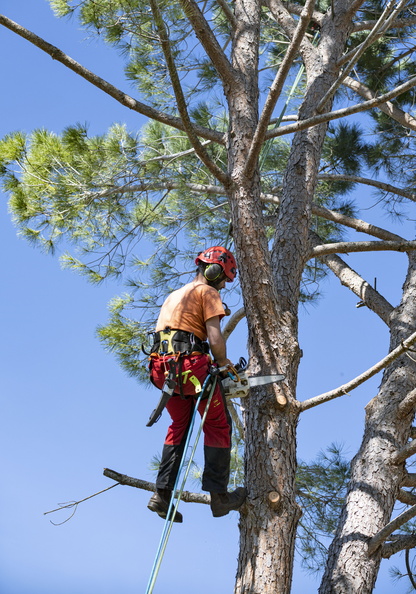The Complete Tree Service Handbook: Types, Benefits, and Steps

Tree service is an essential aspect of maintaining healthy landscapes and ensuring safety in both residential and commercial settings. Whether it’s routine maintenance, emergency removal, or specialized care, tree services play a critical role in managing and preserving our natural environment.
Types of Tree Services
Tree services encompass a wide range of activities, each tailored to meet specific needs and challenges associated with tree care. The primary types of tree services include:
1. Tree Pruning and Trimming: Pruning involves selectively removing branches to improve tree structure, enhance aesthetics, and promote healthy growth. Trimming, on the other hand, focuses on shaping the tree and removing overgrown branches. This service is crucial for maintaining the tree's appearance, health, and safety. Proper pruning techniques help eliminate dead or diseased branches, prevent potential hazards, and allow better light penetration and air circulation within the canopy.
2. Tree Removal: Sometimes, a tree must be removed due to disease, structural damage, or because it poses a threat to property or safety. Tree removal is a complex process that requires careful planning and execution to avoid damaging surrounding structures or landscapes. It involves cutting down the tree in sections, safely lowering them to the ground, and then removing the stump and roots if necessary.
3. Stump Grinding and Removal: After a tree is cut down, the remaining stump can be unsightly and pose a tripping hazard. Stump grinding involves using specialized equipment to grind the stump into small wood chips, which can be used as mulch or removed. Complete stump removal, although more labor-intensive, eliminates the roots and prevents potential issues with new growth or pests.
4. Tree Health Care and Maintenance: This service focuses on diagnosing and treating tree diseases, pest infestations, and other health issues. Arborists may apply treatments such as insecticides, fungicides, or fertilizers to improve tree health. Regular maintenance, including soil aeration and mulching, helps enhance tree vitality and resilience against environmental stressors.
5. Emergency Tree Services: During storms or other emergencies, trees can become hazards due to broken branches, leaning trunks, or fallen trees. Emergency tree services provide immediate response to remove or stabilize trees that pose imminent risks to people and property. This often involves working in challenging conditions and requires specialized equipment and expertise.
6. Cabling and Bracing: For trees with structural weaknesses or heavy limbs, cabling and bracing provide additional support. This involves installing flexible cables or rigid rods to reinforce the tree's structure, preventing branches from breaking and reducing the risk of failure. This proactive measure helps preserve valuable trees and extends their lifespan.
7. Land and Lot Clearing: This service involves removing trees, shrubs, and other vegetation from a designated area to prepare for construction, landscaping, or other development projects. Land clearing requires strategic planning to minimize environmental impact and ensure efficient removal of unwanted vegetation.
Benefits of Tree Service
Engaging in professional tree service offers numerous benefits, including:
1. Enhanced Tree Health and Longevity: Regular pruning and maintenance help trees grow strong and healthy by removing dead or diseased branches and promoting better air circulation. This reduces the risk of infections and extends the tree’s lifespan.
2. Improved Safety: Tree services mitigate potential hazards by addressing issues such as weak branches, leaning trees, and storm damage. Proper care reduces the risk of falling branches or trees, protecting people, property, and infrastructure.
3. Aesthetic Appeal: Well-maintained trees enhance the visual appeal of landscapes, adding value to properties. Pruning and trimming improve the tree’s shape and structure, contributing to a more attractive and harmonious environment.
4. Increased Property Value: Healthy, mature trees can significantly increase property value by providing shade, improving curb appeal, and creating a pleasant outdoor space. Conversely, neglected trees can detract from property value and pose liabilities.
5. Environmental Benefits: Trees play a crucial role in environmental sustainability by absorbing carbon dioxide, providing oxygen, and supporting wildlife habitats. Proper tree care ensures these benefits are maximized, contributing to a healthier ecosystem.
6. Prevention of Damage: Regular tree inspections and maintenance prevent potential damage to buildings, utility lines, and other structures. Proactive care reduces the likelihood of costly repairs and disruptions caused by tree-related issues.
The Tree Service Process
The process of tree service typically involves several steps, each tailored to the specific type of service being provided:
1. Initial Consultation and Assessment: The process begins with a consultation between the property owner and a professional arborist. During this assessment, the arborist evaluates the tree’s condition, identifies potential issues, and recommends appropriate services. Factors considered include the tree’s health, structural integrity, location, and potential risks.
2. Planning and Preparation: Once the assessment is complete, a detailed plan is developed, outlining the scope of work, necessary equipment, and safety precautions. For tree removal or major pruning, this may involve obtaining permits or coordinating with utility companies if the tree is near power lines.
3. Execution of Services: The actual service is performed by a team of trained professionals using specialized equipment. For pruning, branches are carefully cut to avoid damage to the tree and surrounding areas. In tree removal, the tree is cut down into manageable sections, with each piece safely lowered to the ground. Stump grinding or removal is done using machinery to grind or extract the stump and roots.
4. Cleanup and Disposal: After the service is completed, the area is cleaned up, with debris, branches, and other materials removed or processed. Wood chips from stump grinding may be used as mulch, while larger sections of wood can be repurposed or disposed of according to local regulations.
5. Follow-Up and Maintenance: Regular follow-up visits may be scheduled to monitor the tree’s condition, especially if treatments were applied or structural supports were installed. Ongoing maintenance ensures the tree remains healthy and any emerging issues are promptly addressed.
In conclusion, tree service is a vital component of landscape management, offering a wide range of benefits from enhancing tree health to improving property safety and aesthetics. By understanding the various types of tree services and the process involved, property owners can make informed decisions and ensure their trees receive the best possible care. Professional tree services not only contribute to the beauty and value of properties but also play a significant role in preserving the natural environment for future generations.




Comments